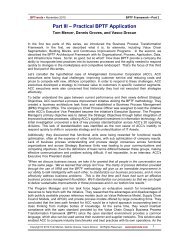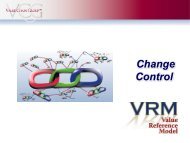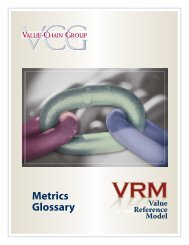BPTF Architecture Overview - Value Chain Group
BPTF Architecture Overview - Value Chain Group
BPTF Architecture Overview - Value Chain Group
- No tags were found...
Create successful ePaper yourself
Turn your PDF publications into a flip-book with our unique Google optimized e-Paper software.
Business Process Transformation FrameworkAuthors:Tom MercerDennis GrovesVasco Drecunwww.value-chain.org<strong>BPTF</strong> <strong>Architecture</strong><strong>Overview</strong>
Copyright©2010<strong>Value</strong><strong>Chain</strong><strong>Group</strong>allrightsreserved|/ExecutiveSummary2ExecutiveSummaryBusinessProcessTransformationFramework(<strong>BPTF</strong>)isanemergingmethodology/technologyforprocessmanagementdirectlytiedtobestpracticesandconfigurableITsystemschoices.Theultimateobjectiveisimprovedalignmentbetweenbusinessstrategy,businessprocesses,peopleandsystemsnecessarytosupportthatstrategy.Thisalignmentreducesbusinessprocesstransformationcycletimesandmitigatesriskofimprovementprojectfailuresandcostoverruns.Fromastrategicviewpoint,<strong>BPTF</strong>providesfunctional/operationalprocessdecompositionandvalueanalysiswhichiscriticalinevaluatingtherelativevalue/contributionofoperationaltacticsandstrategies,existingoperationalprocessesandITportfolios,andultimatelyprovidesasupportfoundationforinvestmentdecisionsandchangesinorganizationdesign,operationalprocessesandinformationtechnology,supportthatminimizesriskandmaximizesthevalueofthoseinvestments.<strong>Value</strong>,however,isintheeyeofthebeholder.Ineveryindustrythereareconsiderationsandtradeoffsthatmustbemadebasedonbusinessstrategy,culture,corecompetencies,competitivepressures,andchangesthatcomefromeverydirection.Intheinsuranceindustry,forexample,StateFarmInsurancebasesitscompetitivestrengthuponitsextensiveagencyenvironmentandpersonalservice–astrategythatcanbemoreexpensivethanothers.ProgressiveandGeico,bycomparison,haveamore“directtoconsumer”strategy.Tosupporteitherstrategy,systemsandprocessescanbedesignedtoprovidepromptclaimsserviceandcustomersatisfaction,butthesecanrepresentasignificantdrainoncashflow.Inmanufacturingcompanies,buildtoorderorengineertoorderstrategiescanprovideforgreatermarketagility,improvedcustomersatisfactionandreducedinventorycosts,butcanalsoaddcapacityandlaborcostscomparedwithamaketostockmassproductionstrategy.Outsourcingcanleadtogreatoperationalefficiency,reducedoverheadexpense,andreducedtimetomarket,butoftencomeswiththetradeoffsoflosingcontroloverproducts,qualityandthecustomerresponsiveness.Thesestrategiesandchoicesprovidethedesignchallengeandresultindifferencesineverydesigninitiative.AprocessdesignsolutiontoacommonbusinessissuewillbedifferentatAMDthanatIntel;thesameprocessesimplementedatStateFarmwillhavedifferentoutcomesNationwide;andsystemsimplementedbyGeneralMotorsmaynotbetherightsolutionforFord.Withshrinkingproductlifecyclesandproductvariantproliferation,manyformerlysequentialbusinessprocessesnowrequireparallelandcrossfunctionalcollaborativeactivities.Withthischange,transactionalinformationflowbetweentraditionalfunctionaldepartmentshasalsochanged,bynecessity,intoarealtimenetworkofdigitaldataoftenspanningtheglobe.Businessprocessesbecomemuchmorecomplexwithcountlessinformationdependenciesasthemanagementfocusexpandsfrominsidethewallsofacompanytoencompassingtheentiresupplychain.Relentlesspressuretospeedtheflowofbusinessinformationisfurtherconfoundedbyrequirementstoprovideinformationinmultiplecontextstomeettheinformationrequirementsofvariousfunctionalgroupsandalllevelsoftheorganization.Simultaneously,companiesarefacingmoreandmoreaggressiveglobalcompetitionandmustbeabletoexpandtheirvaluechainstodealwiththeseglobalchallenges.Beingabletostandardizeandreapplybusinessprocessesquicklyinexpandedoperationsorinacquisitionsbecomesakeystrategytodealwiththisincreasingcomplexityandexpansion.
Copyright©2010<strong>Value</strong><strong>Chain</strong><strong>Group</strong>allrightsreserved|PartIBusinessProcessTransformationFramework3PartIBusinessProcessTransformationFrameworkTheabilitytostandardizeandreapplybusinessprocessmodelswaspioneeredbythemilitarywherestandardizationandnormalizationofactivitiesisrequiredforpreciseplanning,proactivesituationmanagement,andoftensurvival.Ascompetitivepressurescausedmanufacturingsupplychainstorespondmorequicklytocustomerrequirements,whileatthesametimereducinginventoryandcosts,informationflowimprovementstoenablerealtimeavailability,dataintegrityandaccuracyoftransactionsbecameacriticalenablingfactorforsuccessandevensurvivalofabusiness.Withtheneedformultipleenterprisesolutionstoworkinconcert,sharinginformationrealtime,agreementandconsensusonbusinessterminologyandmetricsbecamedramaticallymoreimportant.Referenceprocessmodelsneededfurtherevolutiontocoversupplychainoperationsacrossmultipletradingpartnersandregions,andtomorepreciselydefineenterprisesystemconfigurationstosupporttheincreasingcompetitiverequirements.Today,theneedforaccurateandtimelyinformation,reuseandrapidrepurposingofassetsandknowledgeisexpandingtoallareasofbusinesscommunications.Abilitytointegrate,manageandcontroltheentirevaluechain,spanningvaluecreationanddeliveryprocesses,iscriticalforsustainablecompetitivedifferentiationandlongtermbusinesssuccess.Referencemodelsareexpandingrapidlytoencompassallareasofbusinessactivitiesandinteractionsinordertoimproveprecisionandspeedofinformationsharingwhileincreasingtheflexibilityandagilityofcompaniestomeetchangingbusinessneeds.Preciseandtimelytransformationofbusinessprocessesisacriticalcompetitiveadvantageforanycompanyinanyindustry.Whencorporateleadersfacechallengesofgrowth,profitabilityorsustainabledevelopment,theimmediateobjectivesaretodefineanactionablestrategyandmobilizetheworkforce.Implementingthosestrategies,however,oftenrequirespartialorsubstantialtransformationofbusinessprocesses.<strong>BPTF</strong>playsacrucialrole,focusingleadershipandoperationsontherightpathtomeaningfultransformation.The<strong>BPTF</strong>hasthreetransformationaldimensionsapplicabletoeverycompany:<strong>Value</strong><strong>Chain</strong>Segmentation,BusinessBuildingBlocksandContinuousImprovementPrograms.<strong>Value</strong><strong>Chain</strong>Segmentationdefinesconnectedvaluestreams(orprocessflows)thatmustundergotransformationinorderforacompanytoimproveperformance.BusinessBuildingBlocksdefinebasicactionable(orfunctional)elementsconnectedintovaluestreamsandprocessflowswhichcomprisethevaluechainsegmentation.ContinuousImprovementProgramsaresetsofactionplansthatcanbeexecutedinagiventimeframetomigratethecompanyfromonevaluechaindesigntoanotherwithinthescopeoftransformation.Figure1–<strong>BPTF</strong>Dimensions
Copyright©2010<strong>Value</strong><strong>Chain</strong><strong>Group</strong>allrightsreserved|PartIBusinessProcessTransformationFramework4Thiscomplete,threedimensionalviewoftransformationdefineswhatparticularvaluestreammustundergotransformation,whatactionableitems(functions)areaffectedbyinthetransformation,andhow,overtime,thetransformedvaluestreamsmustevolve.Thefirstpartofthisthreepartarticleseriesdefineseachofthetransformationdimensionsandprovidesinsightsintohowtocompileacompleteandeffectiverepresentationofthetransformedbusinessprocess.<strong>Value</strong><strong>Chain</strong>SegmentationThis<strong>BPTF</strong>dimensiondefinesbusinessprocessesasconnectedvaluestreams.<strong>Value</strong>streamsincludeactivityflowwithexplicitinformationflow(calledinputsandoutputs),businessmetricsandtimelineassociatedwiththeflowinexecution(e.g.,durationoftheprocessfromonepointofI/Ohandofftoanotherpointinthesamevaluestream).Anexampleofavaluestreamis“ordertocash”,witheachactivityclearlydefined,theirI/Oconnectivitydefinedalongwithmetricsandtimelinessofeachtransactionwithintheprocess.<strong>BPTF</strong>Definition:<strong>Value</strong>Stream–anendtoendsetofactivities.Orderfulfillment,forexample,isavaluestreamforwhichtheinputistheorder,andtheresultisthedeliveryoforderedgoods.Orderentryisoneactivityinthecollectionofactivitiesthatconstitutetheorderfulfillmentvaluestream.Segmentation,bothoftheexternalmarketplaceandofanorganization’sinternalvaluestreams,isessentialtomaximizingtheefficiency,effectiveness,profitabilityandcustomersatisfactionratingsofmostorganizations.Therearemanyunfortunateandsometimesterminalexamplesoftheoppositeoutcomefororganizationsthathavenotunderstoodtheimportanceofsegmentation.Essentially,segmentationmeansthatonesizerarelyfitsall.Allcustomersarenotthesame(e.g.,businesscustomerversusconsumer),notallcustomersbuyinthesameway(e.g.,retailoutletversusInternetpurchasesite)andnotallproductsorservicescanbeprovidedusingthesameassetsinthesamefacility(e.g.,youdon’tmakenutsandboltsinachocolatefactorythatmixesnutsandnougat)!Thedifferentiateddemandsofthemarketplaceforproductsandserviceshasimplicationsforhowanorganizationsells,produces,deliversandsupportsthoseproductsandservices.Atypicalglobalcompanyencompassesdifferingbusinessesandmultiplestrategicbusinessunits(SBUs).Fromahighlevelperspective,allSBUshavesimilarities.Forexample,theyallperformfinance,sales,marketing,andotherbasicfunctionalactivities.ButamoredetailedexaminationwillrevealthatsomeofthosefunctionalactivitiesdifferbySBUdependinguponthemarketeachSBUservesandthebusinessobjectivesofeach.<strong>Value</strong>streamsegmentationsimplytranslatesexternalmarketrequirementsintokeyinternaloperatingprocessrequirements.Theseprocessrequirementsmanifestthemselvesasphysicalorvirtualdifferencesinsitelocations,processes,systems,productionlayouts,leadtimes,qualityattributesandskillrequirements.Aneffectiveorganizationdevelopsamarketsegmentationmodelthatmeetsthespecificneedsofitsmarkets,customers,channels,productsandservices.Disciplinedvaluechainsegmentationenablescompaniestounderstandandspecifymorefullywhatexternallyfacingprocessesareneededintheprocessmodelingofthenextstepinthebusinessarchitectureroadmap.
Copyright©2010<strong>Value</strong><strong>Chain</strong><strong>Group</strong>allrightsreserved|PartIBusinessProcessTransformationFramework5Everyglobalcompanymustmasterglobalvaluechainmanagement,whichencompassesawidespectrumofrelationships(supplierOEMdealer),productportfoliosandbrandsandgeographicalregions.Becauseitcanbecompiledinastructuredcatalogueofpredefinedvaluestreamsbuiltwithprovenstandardbusinesselements(activities,I/Os,metricsandpractices),thevaluechainsegmentationdimensionof<strong>BPTF</strong>isoftencalled“businessarchitecture”.Businessarchitecture(BA)isreliedupontoenableprocessstandardizationandharmonizationofinformationmanagementinfrastructure.Inordertosupportstreamliningandcontinuousimprovementofsupplychainglobaloperations,BAmustbeableto:Defineanybusinessprocessatanylocationforanyproduct(platformorprogram)Captureallnecessaryinformationabouttheprocessforcomparativeperformanceanalysisofbenchmarking,cycletime,variabilityandwasteanalysis,maturityanalysisandbusinessrulescomparisonDocumentacompletesetofcapabilityrequirementsforautomationandinformationmanagementforanybusinessprocess.Capabilityrequirementsareusedtoassesscurrentutilizationofcomputingassets,andtoplanacquisitionsofnewcomputingassets.BusinessBuildingBlocksMostpeoplearefamiliarwithLegotoysystem.PlasticLego“bricks”canbeassembledandconnectedinmanyways,toconstructobjectssuchasvehicles,buildingsandevenworkingrobots.Anythingassembledcanthenbetakenapartagain,andthepiecesusedtomakeotherobjects.Legopiecesofallvarietiesareapartofauniversalsystem.Despitevariationinthedesignandpurposeofindividualpiecesovertheyears,eachremainscompatibleinsomewaywithexistingpieces.<strong>BPTF</strong>buildingblocksaresimilartoLegoblocks,butinabusinessprocesscontext.This<strong>BPTF</strong>dimensiondirectlyrelatestopiecesthatcanbeassembledtomodelvaluestreams.Inasense,thisdimensiondeprivesusofunderstandingconnectednessoftheprocesseswithinthevaluechainsegmentationdimension,butpreciselydefineswhateachvalueaddedstepmustaccomplishtokeepthevaluestreamperformingasdesired.Thesestandardbuildingblockshavenormalizeddefinitions(e.g.,eachblockisdefinedonceandinauniqueway)nomatterinhowmanyvaluestreamstheymaybereferencedascomponentvalueaddedenablers.Thus,thebuildingblockscanbestoredindictionarieswheretheyarehierarchicallyorganizedandassociatedwitheachotheraccordingtoapervasiveontologydefiningallassociationswithinandacrossallstructureddictionaries.Forexample,processdictionariesdefinehierarchicaldecompositionofactivitieswithinacompany’sglobalvaluechain,whileinputsoutputsdictionariesdefinealltransactions,documentsandinformationdependenciesbetweentheseactivities.<strong>BPTF</strong>Definfition:Ontology–formallystructuredrepresentationofknowledge(e.g.,medicine)throughdocumentationofknowledgeconcepts(e.g.,physician,patient,illness,treatment,…)andallrelationshipsbetweenthoseconcepts(e.g.,treatmentofanillnessaffectingapatientisprescribedbyaphysician).Ifontologyisusedtodescribesbusinessprocess,thenconceptssuchasactivity,input/output,resourceandmetricscanbeassociatedasin:metricsevaluatesactivityperformedbyaresourcethatproducesinput/output.InordertopopulatetheBuildingBlocks,andthebusinessprocessdefinitiondictionaries,thebusinessarchitectureteammustpreparetheBuildingBlocksstructureandscopeusingoneoftwofundamentalapproaches:
Copyright©2010<strong>Value</strong><strong>Chain</strong><strong>Group</strong>allrightsreserved|PartIBusinessProcessTransformationFramework6DocumentbasedapproachusinggraphicalprocesscaptureModelbasedapproachusingreferencemodelsUsingthefirstapproach,theBAteamcollectsdocumentsandorganizesthebusinessprocessflowdesignscapturedusingprocessrepresentationtemplates,usuallyhardcopygraphicaltemplatesanddrawings.Theprocessisdocumentedatvariouslevelsofdetailindifferentmanualdocumentsanddiagrams.Linkagebetweenthelevelsofprocessdetailisnotpreservedbetweenvariousdocuments.Rather,documentnomenclatureisutilizedtoestablishthehierarchicalstructurefornavigatingthroughcapturedprocessknowledge.Thisapproachiscumbersome,andlessthaneffectiveduetolackofstandardizationofthemodelingelementsandlackoftheprecisionrequiredforautomatedanalysisandexecution.<strong>BPTF</strong>Deinfition:Semantics–thestudyorscienceofmeaninginlanguage.Howwecommunicateandreachagreementonthemeaningofbusinessprocesselements.Themodelbasedapproach,ontheotherhand,solvesthesemanticproblemimposedbyduplicationofelementlistingsacrossmultipleartifacts.Itreliesondevelopmentanduseofreferencemodelsinwhichbuildingblocksaredefinedconsistentlyandaretheonlyonesused(fullynormalized)inalldictionaries.Typically,oneofthedictionariesservesasamaster(highlevel)dictionaryandisanopenstandarddictionary(maintainedoutsideofanyspecificcompany).Otherdictionariescontainadditionalprocesssubsetsanddetailsuniquetoaspecificcompany’soperations.Thereareotherdictionariesdefiningadditionalbuildingblockssuchasdeliverables,inputsoutputs,metrics,resources,rules,practices,technologycomponents,etc.Withinacompany’s<strong>BPTF</strong>,fourtypesofmodelsareoftenfound: Industrylevelneutralreferencemodels(e.g.VRMorAPQP)CompanyspecificextensionsoftheopenstandardmodelProjectreferencemodelsdefiningstagegatedeliverablesSystemfunctionmodelsrepresentingtypicalsystemfunctionsandtransactionsTable1<strong>BPTF</strong>ReferenceModelsFollowingaconsistentontology(setofdefinitionsofbuildingblocksandtheirassociations)enablesreuseofprocessmodelsandcaptureofprocessdesignsatanylevelofdetailrequiredinthemethodologyofcontinuousimprovementandprocessstandardization.ContinuousImprovementProgramsThis<strong>BPTF</strong>dimensionmakesvaluestreamsandbasicbuildingblocksdynamic.Modelingutilizesstandardbuildingblocksandautomaticallygeneratesmodelsdepictingacompany’svaluechainsegmentation.However,modelsarealwaysspecificandrepresentativeofasnapshotintime.Forexample,onemodelcanrepresentaspecificvaluestreamanditsstandardbuildingblocksatthebeginningofanimprovementinitiative(asissnapshot).Othermodelscanrepresentdesireddesignsofthesamevaluestreambuiltfromsamestandardbuildingblocksatvarioustimesinthefuture.Thesemodelsenableanalysisandfacilitateconsensusindeterminingandeliminatingtherootcauseofperformancedegradation.Modelsfacilitateandaccelerateidentificationofperformanceproblemsevenincomplexprocesseswithhundredsoftasksanddependencies.
Copyright©2010<strong>Value</strong><strong>Chain</strong><strong>Group</strong>allrightsreserved|PartIBusinessProcessTransformationFramework7Followingthismodelingapproachandstructure,acompanycanorganizeandarchiveprocessknowledgeforreuse,standardizationandharmonizationofthecomputinginfrastructure.Eachmodeldefinedwithinthethreedimensional<strong>BPTF</strong>isthenavailableforanalysis,comparisonandexecutionusingtheoverallenterprisearchitecturemethodology.Modeldevelopmentprogressesfromastartingpointofindustryneutralstandardstoprocessblueprintsdefiningagranularsetofproceduralstepsandrelatedinformationtransactions,allwhilecompletelyreusingalreadydefinedstandardbuildingblocksandtheirassociations.Aswithallprocesses,the<strong>BPTF</strong>methodologyandprocessmaybedisaggregatedintocomponentsteps.Thekeydifferencebetweenthe<strong>BPTF</strong>methodologyandotherprocessdesignmethodologiesistheabilitytoleverageamodelingapproachincombinationwithprovenbestpracticesinimplementingdesiredchanges.Specifically,<strong>BPTF</strong>supportsthecriticalintegrationofpeople,process,andtoolsrequiredforsuccessfulprocessdesignandimplementationinitiatives.RecognizingtheimportanceofintegratingPeople,Processes,andToolsinasustainablechangeinitiativeisanintegralpartofthe<strong>BPTF</strong>methodology.SomeofthecomponenttasksinchangeinitiativesinvolvingthecombinationofOliverWightandVCGmethodologiesinclude:Diagnostic/DiscoveryThisbriefstepdetermineswhichredesignedbusinessprocessesshoulddeliverthegreatestbenefitstotheorganizationintheshortestamountoftime,andrecommendsapathforwardonajourneytobusinessexcellence.Otherdeliverablesfromthisstepinclude:PotentialbenefitsEducationontheframeworkimplementationmethodologyandtrainingonuseoftheframeworkAnalysisofmanagementreadinessforchangeRecommendedscopeforthefirstimprovementinitiativewithanestimateofcostandbenefits.LeadershipPhaseoftheOliverWightProvenPathInthisstepofthemethodology,SeniorManagersandkeyinitiativemanagersareintroducedtobestpractices,theconceptsandprinciplesofbusinessexcellence,andtoaprovenchangemanagementprocess.Theycreateavisionofthejourneyaheadofthem,establishimprovementpriorities,determinethebusinesscaseforproceedingandcharterateamtoleadtheinitiative.EducationEducationisthecriticalfirststepinbusinessprocesstransformation.Bestpracticeandchangemanagementeducationisfirstprovidedtotheexecutiveteamsotheycanproperlysupporttheinitiativeteam,andtheninmoredetailtotheteamtaskedwithbusinessprocessdesignandexecution.ThisprocesseducationispresentedinparallelwithframeworkeducationinwhichtheimprovementFigure2<strong>BPTF</strong>ApproachtoIntegratingPeople,ProcessesandToolsinChangeInitiatives(CourtesyOliverWightInternational)
Copyright©2010<strong>Value</strong><strong>Chain</strong><strong>Group</strong>allrightsreserved|PartIBusinessProcessTransformationFramework8prioritydimensionsandkeybusinessdriversaredocumented,andanimprovementscorecardandassociatemetricsaredeveloped.DesignWorkshopsAtthispoint,bestpracticeeducationcomestogetherwiththe<strong>BPTF</strong>.Inaseriesofworkshops,designteamsreceiveadditionalprocesseducationandarepresentedwithtemplateOliverWightClassAvaluestreammodelsthattheymodifyforbestfitwiththeirparticularbusinessrequirements.Onlythreedaysarerequiredforeachprocessdesignworkshop,forexampledemandplanning,mastersupplyplanning,andproduct/portfolioreview.Thedesignteamthengoesontocompleteitsformalpolicies,procedures,measurementtrackingsystems,androlesandresponsibilitieswhileotherdesignteamsengageintheirworkshops.Theseworkshopsacceleratecompletionandimplementationofthedetaileddesigns,andenableendtoenddesignanalysistoensureallredesignedprocessesareintegratedandoptimized.Theseworkshopsallowtheorganizationtodrivebusinessbenefitsrapidlytothebottomline—theprimaryfundamentalobjectiveofthismethodology.ProcessMetricsDevelopmentComingoutoftheWorkshopsandfinalendtoenddesignvalidation,theprojectteamsincorporatetherequiredOliverWightClassArequiredmetricsandaddadditionalmetricsbasedonabrainstormingeventutilizingknowledgeoftheirbusinessobjectivesandalibraryof<strong>BPTF</strong>metricsinareusabledictionarycontainingbothOliverWightandVRMmetrics.PACOMThisisanacronymforProcess,Automation,Culture,OrganizationandMetric.ItisauniqueelementoftheIntegratedContinuousImprovementMethodology(ICIM)withinthe<strong>BPTF</strong>methodology.Itspurposeistoidentifythebarrierstochangingbehaviorstomatchtheredesignedbusinessprocesses.Theimplementationteamreachesconsensusonthepotentialbarriersandcreatesactionplanstomitigateoreliminatethesebarriersastheymanifestthemselves.DocumentationoftheNewDesignThedesignprocessendswithpublicationofthecompleteddesignpackageincluding:ProcessDesigndescription,scope,goalsandobjectiveProcessDesign<strong>Value</strong>Card(abalancedsetofmetricsthatbestrepresentsstrategicprioritydimensionofthatprocess)ProcessdescriptionInputoutputdescriptionMetricssummarizedbyprocessstepPracticesbyprocessRolesbyprocessKeyreferencedocumentationbyprocessFormaldocumentation,alongwithassignmentofaprocessownerforeachofthebusinessprocesses,isessentialtosustainabilityofthebusinessprocessandresultingimprovements.Whenprocessdocumentationisnotformalizedbyacompany,itsbusinessprocesseswillnotbealignedorsupportedbypreciseconfigurationofitssystems.Resultswillimproveforatime,butitsbusinessprocesseswillquicklysuccumbtoorganizationalelasticityandlackofsystemssupport.Resultswillreturntopriorunacceptableperformancelevelsandcosts.
Inthenextarticlewewillprovideanoverviewofthe<strong>BPTF</strong>architectureandhowitcanbeusedtodefineallviewsnecessaryforidentifyingandcommunicatingrequirementsforbusinessprocesstransformation.PartII<strong>BPTF</strong>Architectural<strong>Overview</strong>InthePartIweexplainedthat<strong>BPTF</strong>withitsthreedimensionsdefinesprocesstransformationscopesufficientlyandwiththeprecisionrequiredforanalysisandimprovementofprocesses.Buttobeeffective,itneedsalsotoenablecommunicationrequiredforadequatetransformationgovernance,planningandexecution.Thiscommunicationismostefficientwheneachpartyinvolvedintransformationcanclearlydepicttheirconcerns,objectivesandactionsteps.Whenpartiesinvolvedunderstandeachothers’viewsandcanreconciledifferencesduringgovernance,planningandexecution,transformationwillbeefficientandcomplete.<strong>BPTF</strong>definesallviewsnecessaryforidentifyingandcommunicatingwhichpeopleareinvolvedintransformation,whichprocessesareinscope(usingthreedimensionalrepresentationof<strong>BPTF</strong>),whichapplicationsareaffectedbythetransformation,whichdataareinvolvedinthetransformationandwhichbusinessinfrastructureelementsaretouchedbythetransformation.Anychangeinitiativethatdoesnotclearlydefineandcommunicatethesefiveviewsrisksmissingsomeimportantaspectthatwillremainundefinedorvaguelycommunicatedduringplanningandexecution.Thatiswhy<strong>BPTF</strong>requiresexplicitdefinitionofthefiveviewsoftransformation.Figure3<strong>BPTF</strong><strong>Architecture</strong>ViewsCopyright©2010<strong>Value</strong><strong>Chain</strong><strong>Group</strong>allrightsreserved|PartII<strong>BPTF</strong>Architectural<strong>Overview</strong>9
OrganizationalView<strong>Value</strong><strong>Chain</strong>segmentationidentifiesthekeybusinessprocessesthatmustbeexecutedflawlesslyinorderforanenterprisetodifferentiateitselffromitscompetition.Eachcompany’svaluesegmentationisdependentuponitsownorganization,product,andmarketdynamics.Toplevelvaluechainsegmentsshouldhaveasingle,identified,executiveprocessownerwhoisultimatelyresponsibleforthegoals,objectives,design,performanceandcontinuousimprovementofthatprocess.Strategicgoalsfortoplevelsegmentsaresetbyexecutivestakeholdersusing<strong>BPTF</strong>framework“PriorityDimensions”,whichinclude:Asset,Brand,Cost,Innovation,Reliability,SustainabilityandVelocity.PriorityDimensionsselectedestablishthefocusforthebusinessprocessdesignandsupportingperformancemeasurementsystems.Sincebusinessprioritieschangeovertimewithchangingmarketconditions,<strong>BPTF</strong>isdesignedtoenablecompaniestounderstandthepotentialimpactofthosechangesandtoquicklyadapttheirbusinessprocessestonewmarketconditions.Belowisanillustrativeexampleoftypicaltoplevelvaluechainsegmentation:Table2TopLevel<strong>Value</strong><strong>Chain</strong>SegmentationThesesegmentsarefurtherdisaggregatedtoassignmoredetailedlevelsoforganizationalresponsibilityforprocessdesignandperformance.Businessprocessdesignsarethenoptimizedtoenableachievementofbusinessobjectivesandbestinclassperformance.Forexample,thefollowingtablerepresentslowerlevelvaluechainsegmentationofIntegratedBusinessPlanningasdefinedbyOliverWight.Associatedwiththesegmentationistheorganizationalviewdefiningrolesandresponsibilitiesforspecificvaluestreamsandtheirmoredetailedprocesscomponents:Copyright©2010<strong>Value</strong><strong>Chain</strong><strong>Group</strong>allrightsreserved|PartII<strong>BPTF</strong>Architectural<strong>Overview</strong>10
Table3–<strong>Value</strong>StreamSegmentationMultiplescenariosmaybedevelopedtoaccommodatevariantsofthesesegments.Forexample,theremayberequirementstocreateseparateprocessdesignscenariosforMaketoStock,MaketoOrderandEngineertoOrderoperatingstrategiesandenvironments.Similarly,regionalregulatoryandmarketrequirementsmaydemanddifferentprocessflowsthatcanbebuiltfromthesamestandardsetofbusinessbuildingblocks.However,eachdesignmustbeclearlyassociatedwithitsorganizationalviewinordertoidentifypeopleresponsibleforthegovernance,planningandexecutionofprocessesandrequiredtransformations.ProcessViewA<strong>Value</strong>ReferenceModelisananalyticalframeworkthatestablishesaclassificationschemeforbusinessprocessesusingahierarchyoflevelsandrelationshipslinkedbyprocessinputs/outputs.Itestablishesacontextualrelationshiplinkedtobestpracticesandmetricsinordertohelpclassifytheprocessesmostcriticaltoaparticularenterprise.Processviewcanbesingledimensional,bidimensionalorthreedimensionalrepresentationwithinthe<strong>BPTF</strong>.VRMandICIMusemultipleprocessviewstocommunicatemultipleanalysesandscenariosinvolvedinplanningandexecutionoftransformationinitiatives.Copyright©2010<strong>Value</strong><strong>Chain</strong><strong>Group</strong>allrightsreserved|PartII<strong>BPTF</strong>Architectural<strong>Overview</strong>11
Copyright©2010<strong>Value</strong><strong>Chain</strong><strong>Group</strong>allrightsreserved|PartII<strong>BPTF</strong>Architectural<strong>Overview</strong>12The<strong>Value</strong>ReferenceModel(VRM)containsspecificmodelsrepresentingactualflowofworkandinformationinanygivensituation(processmodels)designedinaformthatisreusablebymultiplestakeholders,i.e.,processusers,ITarchitectsandbusinessanalysts.Specifically:PreconfiguredtemplatesfordescribingspecificvaluestreamsCompanyorindustryspecificdictionariesthataredecomposedtotheactivitylevelofanenterprise.Themodelestablishesdomainbasedenterpriseviewsthatenableindustryspecificprocessanalysisandexecution.<strong>BPTF</strong>–baseddesignsactivelylinkmultipleelementsofabusiness,elementswhichareofteninformalandunclearinadocumentbaseddesignapproach.Thefollowingareexamplesofelementslinkedwithin<strong>BPTF</strong>:MetricsassociatedwithanylevelofadisaggregatedprocessandwithvaluechainprioritydimensionsPracticesandproceduresassociatedwithactivitiesatanydetailleveloftheprocess.Technologycapabilitiesrelatedtoactivities,systeminterfacesandtransactionsassociatedwithprocessinputsand/oroutputs.Rolesandresponsibilitiesassociatedwithactivitiesanddeliverables.Themodeltypicallyinvolvesthefollowingdesignhierarchy:<strong>Value</strong>ReferenceModel(VRM):anindustryneutralanalyticalmodelthatestablishesaclassificationschemeforbusinessprocessesusingahierarchyoflevelsandrelationshipsthroughinputs/outputs.ItestablishesacontextualrelationshipwithbestpracticesandmetricstohelpclassifytheprocesseswhicharemostcriticaltoanenterpriseeXtensibleReferenceModel(XRM):companyorindustryspecificdictionariesthataredecomposedfromVRMtoprovidecontextattheactivitylevelofanenterprise.ItestablishesdomainbasedviewsoftheenterprisethatenableindustryspecificprocessanalysisandexecutionSystemFunctionDictionary(SFD):definesallinterfaceswithmethods/functionsrequiredforcollaborativedatamanipulationandinteractionbetweensystemandapplicationfunctionalcapabilities.<strong>Value</strong><strong>Chain</strong>Models(VCM):preconfiguredtemplatesconstructedfromXRMdictionaryelementsfordescribingspecificlinkedprocesstosupportoperationsTherearemanyadvantagesofusingareferencebasedapproachmodel(predefineddictionary)fordesigningorredesigningbusinessprocessesandvalidatinginputsandoutputswithinthoseprocesses.Theextensiblereferencemodel(XRM)isadomainspecificextensionoftheVRM.Itdeliverspreconfiguredbuildingblockswithaccompanyingmetadatastoredinahierarchicalstructurethateliminatesdesignambiguityandguaranteestheuniquenessrequiredtofitaparticularcompanyorbusinessunitwithinacompany.Thus,acomprehensivedefinitionoftheprocesscanbedisplayedandusedforonlinetraining,searchandcomparisonofprocessdesigns,benchmarkingandanalysis.<strong>BPTF</strong>Definition:Metadata–Structureddatawhichdescribethedetailedcharacteristicsofaprocessdesign.Havingaccesstoareferencemodelwhichhasbeendesignedbyaworldclasscommunityofexperts,forexampleIntegratedBusinessPlanningdesignedbyOliverWight,meansthatthedictionaryofbuildingblocksavailabletoyourcompanyissubstantiallycompleteattheoutsetofthedesignactivity.Buildingblocksdesignedinthiswayincludeactivities,deliverables,inputs/outputs,metrics,rules,practices,resources,andtechnologycapabilitiesallintegratedforthespecificbusinessprocessunderreview.The
Copyright©2010<strong>Value</strong><strong>Chain</strong><strong>Group</strong>allrightsreserved|PartII<strong>BPTF</strong>Architectural<strong>Overview</strong>13metadatadefiningthisspecificconstructcanbeeasilymodifiedtoallowforearlyadoptionbyanycompanyanditsvariousbusinessunitswhichmayrequireprocessviewmodificationasbusinessandmarketplaceconditionschange.Regardingpredefinedanddictionarybasedprocessflowdesign,therearesignificantbenefits.“Dictionarybased”meansthatyouhaveaccesstoanarchiveofyourcontrolled,referenceable,discretebusinessprocessesandrelatedinput/outputs.DictionariesinVRMandXRMarepowerfulcomponentsofthe<strong>BPTF</strong>.ConsiderananalogyofthecontentoftheEnglishlanguagedictionarywhichalphabeticallylistswords,theirusesandtheirmeanings.VRM/XRMdictionariesaresimilarlystructured,butinsteadoflistingwords,VRM/XRMdictionarieslistbusinessprocesses,theirdefinitionsandotherrelatedbuildingblocks.Collectively,theyrepresentacommonlanguageusedtofacilitatecommunicationsanddesignconsensusinbuildingormodifyingstructuredbusinessprocesses.CreatinganXRM,orcompanyspecificvaluechainmodel,issimilartowritingabookusingtheprocessdefinitions(words)fromthedictionary.Justasabooktakesoncontextaswordsareassembledintoabook,,sotheXRMdevelopsitscontextthroughtheassembledprocesselementsusedto”write”,forexample,a“book”describingacompany’sMTO,MTS,orATOplanningstrategies.And,aswithanEnglishlanguagedictionary,thecontentofthedictionaryisnotconsumedthroughitsuse.Thedictionaryelementscompriseareusable,editable,andsustainablerepositoryofintellectualpropertyandprocessbuildingblocks.Theenterprisearchitectwillfindthisfeaturecriticallyimportantinsupportingprocessanalysisandcontinuousimprovement.Havingaccessto“predefined”dictionariesmeansthatprocessmodelingissimplifiedtoanactivityofdisplayinganacceptablestandardprocessdesignandthenaddingtoormodifyingitwhenconditionsrequire.Forbusinessleaders,thisfeaturecompletelyeliminates“semanticnoise”(nonvalueaddeddiscussionsovertheconstructandmeaningofbusinessprocessesandtheirsystemsupportingtransactions).ItmakescommunicationsbetweenthebusinessandITfunctionsand/orsystemsintegratorspreciseandroutine.Systemconfigurationisnolongeratrialanderrorexercise,butaprecisetranslationofbusinessprocessrequirements.HavinganarchiveofprocessbuildingblocksinacompanyspecificXRM,ratherthananopensystemssetofgenericmodels,allowsacompanytoeasilyupdateandaddadditionalbuildingblocks.Thismodelbasedprocessdocumentationtherebyenhancesthecompany’scapabilitytocontinuouslyupdateprocessdocumentationtoreflectwhatisactuallyneededtorunthebusinessinaneverchangingenvironment.AdvantagesofamodelbasedapproachoveradocumentbasedapproachAreferencemodeldrivenbuildingblockstructureallowsacompanytoquicklyassembleprocessviewswhichcommunicatecompletebusinessprocessdesignsusingspecificattributesandmodificationstoaccommodateidiosyncrasiesinanygiveninstanceofaprocess.Thedesignteamcanproposemodificationsandthenautomaticallygenerateadocumentforcirculation,reviewandverificationpriortoimplantingthenewprocessdesign.Alternatively,ahardcopydocumentdescribingabusinessprocessisextremelydifficultandcumbersometodecomposeintoitsmanyelementsforreview,modificationorcontinuousimprovement.Certainlyadocumentisdesirableandevennecessaryfortheprocessownerandusers,butthedesignteamshouldnothavetowastetimedevelopingthatmonolithicdocument.
Copyright©2010<strong>Value</strong><strong>Chain</strong><strong>Group</strong>allrightsreserved|PartII<strong>BPTF</strong>Architectural<strong>Overview</strong>14Ratherthanrequiringadesignteamtocreatemonolithic,manuallyproduceddrawings,amodeldriven,or<strong>BPTF</strong>,approachenablesconfigurationandautomaticdisplayofmodelsandautomaticallyproducesafullrepresentationoftheprocessflow.Withadocumentbasedapproach,itisverydifficulttoreuseprocessknowledge,standardizeonbasicbuildingblocksorprovideaninteractivearchivewithwhichtoanalyze,reuseandrepurposebusinessprocessbuildingblocks.Consider,too,thatdocumentbasedmodelingservesnousefulpurposeinthesystematicexecutionofanygivenprocess.Forexample,itisn’tpossibletofeedaVisiodiagramintoaBPMS(BusinessProcessManagementSystem)andwatchitexecute.Gooddesignworkistrappedandstrandedinastaticdocumentbasedmodel.Contrastthiswithamodelbasedapproachwhereviewsareextensibletocommunicatemultipleconcernswhilereusingelementsfromthesamemodelingdictionary.ServiceOriented<strong>Architecture</strong>(SOA),asetofguidelinesandrecommendationsusedtoviewbusinessprocessasconnectedruntimecomputingandhumanservices,canconsumemodelbasedprocessviewsintoanexecutableapplication(viawebservices).Thus,themodels,usedtocommunicateduringplanningandanalysisofthetransformation,canalsobeembellishedfollowingSOAguidelinestobefullyexecutableinruntimewithhumansandmachinesinterpretingtherequiredinformationflowstoprovidetimelyvalueaddedservices.ButthebenefitofadoptingtheBusinessTransformationFrameworkdoesnotendthere.Theframeworkwill:AcceleratebusinessprocessdesignandtransformationSimplifyandacceleratecaptureofbusinessprocessmodelsFacilitateanalysisofbusinessprocessoutcomevariability,gapstodesignobjectivesandprocessbottlenecksEnablereapplicationorrepurposingofprocessknowledgeincludingactivities,inputs/outputs,practices,roles,policiesandprocedures,technology,etc.throughdictionaryarchitectureImproveprecisionandconsistencyofbusinessprocessesEnableconsensusonbusinesssemantics(meaningandusageofprocessterminology)Allowandensurestructuralintegrityofcomplexendtoendprocessflows(valuestreams)Preserve,throughitsarchivestructure,businessprocesselementrelationshipsandinherentinformation(whereusedbyI/O,byprocess,bymetrics,bytechnology,byproduct,allowsefficientadaptationandadoptionofchanges)Theadvantagesofthe<strong>BPTF</strong>listedaboveresultinincreasedvelocityinadaptingbusinessprocessestomeetchangingmarketplaceconditions.Thattranslatestoincreasedrevenueandprofitforanycompanyregardlessofindustry.ApplicationViewFrequentlythemostchallengingstepinanERPimplementationisthetranslationoftheProcessViewintotheApplicationView,i.e.,configurationofthesoftwaretosupportdefinedbusinessprocessrequirements.Animprecisetranslationofawelldesignedbusinessprocesswillsuboptimizeacompany’sresultsanderodethevalueofasystemimplementation.Systemsfunctionsdictionariesareusedbysoftwarevendorstolistspecificsystemfunctionalitiesavailabletoendusers.Thesesystemsfunctionsdictionariesdefinethetransactionsandinteractionsbetweenusersandthesystemwhichexecuteapplicationfunctionalcapabilities.
Copyright©2010<strong>Value</strong><strong>Chain</strong><strong>Group</strong>allrightsreserved|PartII<strong>BPTF</strong>Architectural<strong>Overview</strong>15SAP,forexample,providesacomprehensiverangeofbusinesssoftwareandenterpriseapplications,designedforglobaloperationsandsupportedwithglobalizationservices,toempowereveryaspectofacompany’sbusiness.Bymerging<strong>BPTF</strong>supportedbusinessprocessrequirementswithsystemtransactionscontainedinSAPBusinessMaps,acompanygainsthevisibilitytopinpointprocessinefficienciesandthecapabilitytotransformthemintocompetitiveadvantages.Additionally,thecompanywillhavetheabilitytorespondquicklytonewopportunitiesidentified,thefunctionalitytooptimizeoperationsandresourcesaschangesarerequired,andtheabilitytoextendbestpracticesacrossitsendtoendvaluechain.Solutionmaps,suchasSAP’s,canhelporganizationsunderstandhowsoftwaresolutionscansupportkeybusinessprocesses.However,thesesystemsapplicationsarenotnecessarilyconfiguredtomeettheneedsofeverycompany.Applicationsmustconformtoprocessviewsandorganizationalviewsinordertoensurethatpeopleareusingapplicationsproperlyateachprocessstep.Thatalignmentrequiresprecisespecificationsregardinghowtoconfigureapplicationstosupportprocessesasdemandedbythetransformationobjectives.Suchdepictionsareoftencalledblueprints.Blueprintsrepresentdetailedspecificationsofrequiredapplicationfunctionalitytosupportprocessflows.Mostapplicationsusedintoday’sbusinessworlddonotcomewithblueprintsthatcanbereusedandrepurposed.Theyaresimplystandardsoftwareprogramsthatprovideuserswithspecificinformationmanagementfunctionswhicharenotpreintegratedtosupportspecificflowsofinformationacrossandbetweenapplications.Applicationprogramminginterfaces(API)areusedtopreparecrossapplicationdataexchangespecificationswithinblueprints.BecausemanyapplicationsprovideproprietaryAPIs,itbecomesanalmostimpossibletasktocomprehendandorganizeallpossibilitiesinvolved.Yet,therearealimitednumberoftheseinterfacesthatcanbeused.Toreduceexpensesandaccelerateintegration,modernapplicationsresorttopublishingtheAPIsandfollowingoneormoreopenstandardsfordefiningtheirAPIsandextendedfunctionalities.Applicationsslowlybecomeenabledassetsofvalueaddedservices(withAPIsgovernedwithinastandardpurviewofSOA)canbeassembledatanygranularleveloftheprocessflowenablingflexibleexecution.Thisgranularizationofapplicationsprovidestremendousflexibilityandagility,butinordertomanageandcontainexcessivecomplexitythatgoeswithit,itmustbeaccomplishedbyastructuredanddisciplinedapproachenabledbytheSFDwithinthe<strong>BPTF</strong>topdownapproach.Figure5 SAPIndustryMapTranslationFigure4 <strong>BPTF</strong>TopDownApproach
Copyright©2010<strong>Value</strong><strong>Chain</strong><strong>Group</strong>allrightsreserved|PartII<strong>BPTF</strong>Architectural<strong>Overview</strong>16Process_Level_1PK,U1LevelOneIdentityU2LevelOneIDU3LevelOneNameLevelOneDefinitionLevelOneSeqFK1,U3,U2,U1LevelZeroIdentityReportColorVisioForeColorVisioBkgndColorI1MasterIdentity<strong>Value</strong>LinkUserDefinedProcess_Level_2PK,U1LevelTwoIdentityU2LevelTwoIDU3LevelTwoNameLevelTwoDefinitionLevelTwoSeqFK1,I1LevelOneIdentityFK1,U3,U2,U1LevelZeroIdentityFK2,I2ProcessTypeIDReportColorVisioForeColorVisioBkgndColorI3MasterIdentity<strong>Value</strong>LinkUserDefinedProcess_Level_3PKLevelThreeIdentityU1LevelThreeIDLevelThreeNameLevelThreeDefinitionFK1,I1LevelTwoIdentityFK1,U1LevelZeroIdentityI2MasterIdentity<strong>Value</strong>LinkUserDefinedL3_to_PIPPK,FK2,I1LevelThreeIdentityPK,FK1,I2PipIDL3_to_PracticePK,FK2,I1LevelThreeIdentityPK,FK1,I2PracticeIDPracticePKPracticeIDPracticeNameFK1,I1PracticeClassFK1,I1PracticeSubClassPracticeDefinitionUserDefinedKeyPracticeI2MasterIdentity<strong>Value</strong>LinkPIPPKPipIDFK1,I1SegmentIDPipDescPipPurposeInput_Output_ClassPKIOClassIOClassDescriptionUserDefinedPractice_ClassPKPracticeClassPracticeClassDescriptionUserDefinedPip_ClusterPKClusterIDClusterDescPip_SegmentPKSegmentIDFK1,I1ClusterIDSegmentDescL3_to_IOPKL3toIOIDFK1,I1InputOutputIDFK2,I2SourceLevelThreeIdentityFK3,I3TargetLevelThreeIdentitySourceExternalTargetExternalI4MasterIdentityUserDefinedInput_Output_SubClassPK,FK1,I1IOClassPKIOSubclassIOSubClassDescriptionUserDefinedPractice_SubClassPK,FK1,I1PracticeClassPKPracticeSubClassPracticeSubClassDescriptionUserDefinedL3_to_MetricPK,FK1,I1LevelThreeIdentityPK,FK2,I2MetricIDMetricPKMetricIDMetricNameFK1,I1MetricClassFK1,I1MetricSubClassMetricDefinitionFK2,I2UnitOfMeasureFormulaUserDefinedKeyMetricFK3PDIDI3MasterIdentity<strong>Value</strong>LinkMetric_ClassPKMetricClassMetricClassDescriptionUserDefinedMetric_SubClassPK,FK1,I1MetricClassPKMetricSubClassMetricSubClassDescriptionUserDefinedBenchmarkPKBenchmarkIDFK1,I1BenchmarkSourceIDBenchmarkParityBenchmarkAdvantageBenchmarkSuperiorFK2,I2MetricIDI3MasterIdentityUserDefinedBenchmark_SourcePKBenchmarkSourceIDBenchmarkSourceNameBenchmarkSourceDescription<strong>Value</strong>LinkI1MasterIdentityUserDefinedPractice_to_TechnologyPK,FK1,I1PracticeIDPK,FK2,I2TechnologyIDTechnologyPKTechnologyIDTechnologyNameTechnologyDefinitionFK1,I1TechnologyClassFK1,I1TechnologySubClassUserDefinedKeyTechnologyI2MasterIdentity<strong>Value</strong>LinkProcess_TypePKProcessTypeIDTypeNameTypeDefinition<strong>Value</strong>_<strong>Chain</strong>PK<strong>Value</strong><strong>Chain</strong>Identity<strong>Value</strong><strong>Chain</strong>ID<strong>Value</strong><strong>Chain</strong>Name<strong>Value</strong><strong>Chain</strong>DescriptionCreatedByDateCreatedGoalsObjectivesScenarioPKScenarioIdentityFK1,I1<strong>Value</strong><strong>Chain</strong>IdentityScenarioNameScenarioTypeScenarioDescriptionCreatedByDateCreatedObjectivesScenario_to_LocationPK,FK1,I1ScenarioIdentityPK,FK2,I2LocationIdentityFK3RelationshipTypePartnerTypeFK4DesignStrategyFK5ChannelStrategyFK6ProductStrategyTierSequenceLocationPKLocationIdentityLocationIDLocationNameLocationAddressLocationAddress2LocationCityLocationStateLocationPostalCodeLocationCountryLocationDescriptionFK2LocationTypeFK1,I1CompanyIdentityLatitudeLongitudeIconPhoneFaxGlobalIDCompanyPKCompanyIdentityCompanyIDCompanyNameCompanyDescriptionCreatedByDateCreatedFK1RoleFolderIDMetric_to_Loc_to_L3_to_ProdPK,FK3,I3ScenarioIdentityPK,FK3,I3LocationIdentityPK,FK3,I3LevelThreeIdentityPK,FK3,I3ProductIdentityPK,FK2,I2MetricID<strong>Value</strong>FK1,I1BenchmarkIDKeyMetricFK4MetricCategoryIO_to_Loc_to_L3_to_ProdPKIOLocL3IDFK1,I1InputOutputIDFK4,FK5,I3,I2ScenarioIdentityFK4,I2SourceLocationIdentityFK4,I2SourceLevelThreeIdentityFK4,I2SourceProductIdentityFK2,I4SourceProcessActivityInstanceSourceExternalFK5,I3TargetLocationIdentityFK5,I3TargetLevelThreeIdentityFK5,I3TargetProductIdentityFK3,I5TargetProcessActivityInstanceTargetExternalMinDurationAvgDurationMaxDurationFK6,FK7IOTypeFK6,FK7IOSubtypeFK6IOSubTypeCategoryMinProbabilityAvgProbabilityMaxProbabilityLoc_to_L3_to_ProdPK,FK1,I1ScenarioIdentityPK,FK1,I1LocationIdentityPK,FK1,I1LevelThreeIdentityPK,FK2,I2ProductIdentityPractice_to_Loc_to_L3_to_ProdPK,FK3,I3ScenarioIdentityPK,FK3,I3LocationIdentityPK,FK3,I3LevelThreeIdentityPK,FK3,I3ProductIdentityPK,FK1,I1PracticeIDFK2,I2PracticeStatusIDKeyPracticePractice_StatusPKPracticeStatusIDPracticeStatusNamePracticeStatusDescProcess_Activity_to_Loc_to_L3_to_ProdPKProcessActivityInstanceFK3,I3ScenarioIdentityFK3,I3LocationIdentityFK3,I3LevelThreeIdentityFK3,I3ProductIdentityFK1,I1ProcessActivityIdentityProcessLevelFK2,I2Parent_ProcessActivityInstanceSequenceProcessActivityTypeProcess_ActivityPKProcessActivityIdentityProcessNameProcessActivityDescriptionRevisionRevisionDateIssuedByApprovedByLinkTechnology_SubclassPK,FK1,I1TechnologyClassPKTechnologySubClassTechnologySubClassDescriptionUserDefinedTechnology_ClassPKTechnologyClassTechnologyClassDescUserDefinedRolePKRoleIdentityRoleNameRoleDescriptionIssuePKIssueIdentityIssueIDIssueDescriptionRecommendationIssue_to_Loc_to_L3_to_ProdPK,FK2,I2ScenarioIdentityPK,FK2,I2LocationIdentityPK,FK2,I2LevelThreeIdentityPK,FK2,I2ProductIdentityPK,FK1,I1IssueIdentityRole_to_Loc_to_L3_to_ProdPK,FK2,I2ScenarioIdentityPK,FK2,I2LocationIdentityPK,FK2,I2LevelThreeIdentityPK,FK2,I2ProductIdentityPK,FK1,I1RoleIdentityTechnology_to_Loc_to_L3_to_ProdPK,FK2,I2ScenarioIdentityPK,FK2,I2LocationIdentityPK,FK2,I2LevelThreeIdentityPK,FK2,I2ProductIdentityPK,FK1,I1TechnologyIDFK3PracticeStatusIDKeyTechIsAServiceBusiness_RulePKRuleIdentityRuleNameRuleDescriptionPriority_DimensionPKPDIDPDNamePDDefinitionI1MasterIdentityUserDefinedCompetitive_RequirementPK,FK2,I2ScenarioIdentityPK,FK1,I1PDID<strong>Value</strong>Unit_Of_MeasurePKUnitOfMeasureModel Framework<strong>Value</strong> <strong>Chain</strong>ModelRe-UseableTemplatesCopyright © 2008,<strong>Value</strong> <strong>Chain</strong>AssociatesIf the ScenarioId is associated withthe <strong>Value</strong><strong>Chain</strong> named "Templates"then only Locations associated withthe Company Named "Templates"may have an entry in theScenario_to_Location TableOnly ScenarioID's associated withthe <strong>Value</strong><strong>Chain</strong> named "Templates"may have an entry in theTemplate_To_Folder table.LifecyclePKLifecycleIdLifecycleDescriptionSortOrderI1MasterIdentityDecisionPKDecisionDecisionDescriptionContinuousRecursiveGatedSelectionYes/NoFK1,I1LifecycleIDDecision_DependencyPK,FK1,I1ProviderDecisionPK,FK2,I2DependentDecisionDecisionsConfiguration_MetricPK,FK1,I1ConfigurationIDPK,FK1,FK2,I2,I1LevelThreeIdentityPK,FK2,I2MetricIDConfiguration_PracticePK,FK1,I1ConfigurationIDPK,FK1,FK2,I2,I1LevelThreeIdentityPK,FK2,I2PracticeIDConfiguration_IOPK,FK1,I1ConfigurationIDPK,FK1,I1LevelThreeIdentityPK,FK2,I2L3toIOIDConfigurationPKConfigurationIDConfigurationNameConfigurationDescriptionFK1,I1ConfigurationClassFK1,I1ConfigurationSubClassI2MasterIdentity<strong>Value</strong>LinkUserDefinedConfiguration_Level3PK,FK1,I1ConfigurationIDPK,FK2,I2LevelThreeIdentityPre-DefinedConfigurationsu:Cd:Ru:Rd:Ru:Cd:Ru:Cd:Cu:Cd:Cu:Cd:Ru:Cd:Ru:Cd:Cu:Cd:Ru:Rd:Ru:Rd:Ru:Cd:Cu:Rd:Ru:Rd:Ru:Cd:Cu:Cd:Cu:Rd:Ru:Cd:Cu:Cd:Cu:Cd:Cu:Rd:Ru:Cd:Ru:Cd:Ru:Cd:Cu:Cd:Ru:Cd:Ru:Cd:Cu:Cd:Cu:Rd:Ru:Cd:Cu:Rd:Ru:Rd:Ru:Cd:Cu:Cd:Ru:Rd:Ru:Cd:Cu:Cd:Ru:Cd:Ru:Cd:Ru:Cd:Cu:Rd:Ru:Cd:Cu:Cd:Cu:Rd:Ru:Cd:Ru:Cd:Ru:Cd:Cu:Cd:Ru:Cd:Ru:Rd:RProductPKProductIdentityProductNameProductDescriptionProductLinkFK1PictureIDu:Rd:Ru:Rd:RScenario_to_ProductPK,FK1,I1ProductIdentityPK,FK2,I2ScenarioIdentityFK3LifecycleIdu:Cd:Cu:Cd:Cu:Rd:RProduct_to_DecisionPK,FK1,I1ScenarioIdentityPK,FK1,I1ProductIdentityPK,FK2,I2Decisionu:Cd:Cu:Rd:RProcess_Level_0PKLevelZeroIdentityU2LevelZeroIDU1LevelZeroNameLevelZeroDefinitionLevelOneDefinitionLevelTwoDefinitionLevelThreeDefinitionI1MasterIdentity<strong>Value</strong>LinkUserDefinedDictionaryTypeu:Cd:RBusiness_Rule_to_Loc_to_L3_to_ProdPK,FK2,I2ScenarioIdentityPK,FK2,I2LocationIdentityPK,FK2,I2LevelThreeIdentityPK,FK2,I2ProductIdentityPK,FK1,I1RuleIdentityu:Rd:RL1_to_MetricPK,FK1,I1LevelOneIdentityPK,FK2,I2MetricIDu:Cd:Cu:Cd:CL2_to_MetricPK,FK1,I1LevelTwoIdentityPK,FK2,I2MetricIDu:Cd:Cu:Cd:CConfiguration_SubClassPK,FK1,I1ConfigurationClassPKConfigurationSubClassConfigurationSubClassDescUserDefinedConfiguration_ClassPKConfigurationClassConfigurationClassDescUserDefinedu:Cd:Ru:Cd:RProduct_PicturePKPictureIDPictureImageu:Rd:RCompany_FolderPKFolderIDU1FolderNameFK1,U1Parent_FolderIDu:Rd:RCompany_to_FolderPK,FK1FolderIDPK,FK2CompanyIdentityu:Cd:CRole_FolderPKFolderIDU1FolderNameFK1,U1Parent_FolderIDu:Rd:RRole_to_FolderPK,FK1RoleIdentityPK,FK2FolderIDu:Cd:Cu:Cd:CProcessActivity_FolderPKFolderIDU1FolderNameFK1,U1Parent_FolderIDProcessActivity_to_FolderPK,FK1ProcessActivityIdentityPK,FK2FolderIDu:Rd:Ru:Rd:Ru:Rd:RProduct_FolderPKFolderIDU1FolderNameFK1,U1Parent_FolderIDProduct_to_FolderPK,FK1ProductIdentityPK,FK2FolderIDu:Cd:Cu:Cd:Cu:Rd:RTemplate_FolderPKFolderIDU1FolderNameFK1,U1Parent_FolderIDTemplate_to_FolderPK,FK1ScenarioIdentityPK,FK2FolderIDu:Cd:Cu:Cd:Cu:Rd:Ru:Rd:Ru:Rd:Ru:Cd:Cu:Rd:Ru:Cd:Cu:Cd:Cu:Rd:RIssueFolderPKFolderIDU1FolderNameFK1,U1Parent_FolderIDu:Rd:RIssue_to_FolderPK,FK1IssueIdentityPK,FK2FolderIDu:Cd:Cu:Cd:CBusinessRule_to_FolderPK,FK1RuleIdentityPK,FK2FolderIDBusinessRuleFolderPKFolderIDU1FolderNameFK1,U1Parent_FolderIDu:Cd:Cu:Cd:Cu:Rd:Ru:Cd:Cu:Cd:Cu:Cd:Cu:Cd:Cu:Cd:Cu:Cd:Cu:Cd:Cu:Cd:Cu:Rd:Cu:Cd:Ru:Rd:R<strong>Value</strong>Point_ControlPKApplicationVersion_MajorPKApplicationVersion_MinorPKApplicationVersion_RevisionChannel_StrategyPKChannelStrategyDesign_StrategyPKDesignStrategyPartner_TypePKPartnerTypeRelationship_TypePKRelationshipTypeProduct_StrategyPKProductStrategyu:Cd:Ru:Cd:Ru:Cd:Ru:Cd:RLocation_TypePKLocationTypeu:Cd:Ru:Rd:RLoc_to_L3PK,FK1ScenarioIdentityPK,FK1LocationIdentityPK,FK2LevelThreeIdentityFK3ConfigurationIDAddedViaL2FK4ProcessCategorySequenceIO_Dependency_ExceptionPK,FK1OutputIDPK,FK2IndependentInputu:Rd:RIO_TypePKIOTypeIOTypeDefinitionUserDefinedIO_SubTypePK,FK1IOTypePKIOSubtypeIOSubTypeDefinitionUserDefinedIO_SubType_CategoryPK,FK1IOTypePK,FK1IOSubtypePKIOSubTypeCategoryIOSubTypeCategoryDescriptionUserDefinedu:Cd:Ru:Cd:Ru:Cd:RInput_OutputPKInputOutputIDIONameFK1,I1IOClassFK1,I1IOSubclassIODefinitionUserDefinedKeyIOI2MasterIdentity<strong>Value</strong>LinkFK2IOTypeu:Rd:Ru:Rd:Ru:Cd:Cu:Cd:RMetric_to_Loc_to_L2_to_ProdPK,FK1ScenarioIdentityPK,FK1LocationIdentityPK,FK2LevelTwoIdentityPK,FK3ProductIdentityPK,FK4MetricIDFK5BenchmarkIDKeyMetricu:Cd:Cu:Cd:Ru:Rd:RMetric_to_Loc_to_L1_to_ProdPK,FK1ScenarioIdentityPK,FK1LocationIdentityPK,FK2LevelOneIdentityPK,FK3ProductIdentityPK,FK4MetricIDFK5BenchmarkIDKeyMetricu:Cd:Cu:Cd:Ru:Cd:Cu:Cd:Ru:Rd:RProcess_CategoryPKProcessCategoryMetric_CategoryPKMetricCategoryu:Cd:Ru:Cd:R<strong>Value</strong>ScapeExport_ControlPKApplicationVersion_MajorPKApplicationVersion_MinorPKApplicationVersion_Revision<strong>BPTF</strong>Meta ModelEnterprisearchitectsuseapplicationviewsextensivelytodepictapplicationsinvolvedinprocessflowsandtoanalyzepossibilitiestointegrateinformationflowsevenwhentheyhavetocrossapplicationswithinorbetweencompanies.DataViewProcessflowsarealwaysassociatedwithinformationflowsthroughconnectedinputsandoutputs.Whetherlookingatasupersetofdatadefinitionsinaspecificprocessflow,orjustanalyzingindividualI/Os,wehavetodefinethesemanticvalueofeachinformationaldependency.Semanticvalueoftheinformationissimplyaddressingwhatthatinformationistryingtocommunicateandtowhom.Thus,describingacustomerordermaybedoneinalargedocumentwithmanyspecificdataelementswithinit.Elementssuchascustomernameandbilltoaddressmaybecommonlyunderstoodandusefultomanyparticipantsintheordermanagementprocessflow,butsomeofthemorespecificdataelements,suchasbuyingcontractandorderentrydate,maynotbeofinteresttoeveryone.Oncewedefineaprocessflowandassignconnectivitybetweeninputsandoutputs,wecanassessthetotalinformationmodelinvolved,analyzesemanticvalueofspecificI/OsanddeterminethebeststrategyforinterfacingdatawheneverI/Oscrosssystemdomainswheretheinformationissupposedtoreside.Thisviewthenenablesassessmentofvariousstrategiesformanagingmasterdata,interfacingrequirements,orsimplytrainingrequirementsrelatedtotheuseofcertaininformationmanagementtoolsandsystems.Thedataviewisimportantbecauseithelpsdetermineiftherightinformationisbeingpresentedtotherightpeople(maximumsemanticvalue);whetherthereareinstrumentsinplacetoprovideaccurateandtimelyinformation;andwhetherthereiscompleteunderstandingbyallparticipantsofwhoisresponsibleforwhatdataelements,aswellasformaintenanceandupdatingmasterdatacommonlysharedbymultiplesystems.InthedictionariesdefiningbasicbuildingblockswecanorganizeandfinddefinitionsofeachI/O,oftenwithadditionalinformationonitsinterfacingpossibilities,masterdatacontainedinthem,etc.Oncetheprocessflowsareassembledforanalysisandtransformationplanning,dataviewsenableustodeterminethebeststrategyforintegrationandtransactionalintegrityoftheinformationflows.<strong>BPTF</strong>requiresthatallinputs/outputsrepresentinginformationflowsbeorganizedinthedictionarieswithextensibleclassificationsandnormalizeddefinitionsofclassesandindividualinput/outputs.Followingsimilarrequirement,theinformationmodelofthe<strong>BPTF</strong>itselfbecomesastructuredmetamodelgovernedbyVCG(Figure6).ThismetamodelenablesvarioustoolsformodelingandanalyzingFigure6 <strong>BPTF</strong>MetaModel
usinessprocessesinthreebasicdimensions,aswellascommunicatingfivecriticalviewsduringprocesstransformation,toexchangedataandfacilitatebusinesspracticesreuseandstandardization.InfrastructureViewWheneverinformationsystemsarerequiredtosupportinformationflows,wehavetounderstandthecriticalaspectsofinformationaccessibility,security,scalabilityandreusability.Aligningtheprocessviewwiththedataviewprovidesforgreatlogicalunderstandingoftransformationalchanges,However,withoutactualconfirmationthattheinformationdependentontheITinfrastructurewillbeproperlyadministeredandprovidedwhenrequired,wehavelittleconfidenceinourabilitytoimplementtheprocesstransformation.ManydevicesareusedtodayinthemodernITlandscapetosupportinformationmanagement.Computersofferingdatamanagement,computersofferingbusinesslogiccalculations,computersmanagingaccessandusercredentials,storagedevices,routersconnectingcomputerstothenetwork,printers,mobilecommunicationdevices,networkswitchesandtelecommunicationservers,allplayaroleinmakingsuretherightpeoplegettherightinformationinaccordancewiththeprocessflow.Oncewemaptheprocessviewandreconcileitwiththedataandinfrastructureviews,webegintounderstandthetruecostofconnectingpeoplewithinformation,maintainingandsupportingvariousupgradesandchanges,thepossibilitiesofusingstandardtechnologies,risksofoutdatedequipment,etc.Theinfrastructureview,therefore,mustbereconciledwiththedataandprocessviewstoprovidefullunderstandingofthecostandperformanceofinformationconnectivityacrossallvaluechainsegments,withinaspecificvaluestreamorbetweenspecificvaluestreams.SummaryInthisarticlewehavedescribedhowdifferentviewsoftheprocesstransformationmustbeassembledtocommunicateconcerns,planpossibilitiesandtransformactivities.Withoutallviewssomeimportantaspectoftransformationmaybemissed,causingvaluabletimeloss,budgetunderestimatesandinternaldisagreementsonimportantchangerequirements.Thethreebasic<strong>BPTF</strong>dimensionsenableustodescribethedynamicnatureofprocesschangesateverylevelofdetailimportantforanalysis,planningandtransformationexecution.Thefiveviewsenableustocommunicateallimportantaspectsoftransformationtoensurethatwehaveproperlyassignedresponsibilities,changerequirements,applicationfunctionalityrequirementsandinfrastructurerequirements,aswellasensuringthatwehaveproperlyunderstoodthedatainvolvedinthetransformation.Ourownexperiencetellsusthattheremaybeotherimportantcompanyspecificaspectstocommunicate,suchascostsandresourcesduringtheplanningandexecutionofthetransformation.However,wehavedeterminedthatmostotherimportantaspectsareinsomemannersimplyattributesorderivativesoftheelementalfiveviews,ortheircombination,thatmustbecapturedandcommunicated.Copyright©2010<strong>Value</strong><strong>Chain</strong><strong>Group</strong>allrightsreserved|PartII<strong>BPTF</strong>Architectural<strong>Overview</strong>17
Copyright©2010<strong>Value</strong><strong>Chain</strong><strong>Group</strong>allrightsreserved|PartIIIPractical<strong>BPTF</strong>Application18Thethreedimensions(<strong>Value</strong><strong>Chain</strong>Segmentation,BuildingBlocksandContinuousImprovementPrograms)addresscompletenessofbusinessprocessrepresentationsrequiredduringthetransformation,whilethefiveviewsgiveustheabilitytocommunicateallkeytransformationconcerns.Inthenextarticlewewillprovideapracticalapplicationofhowthe<strong>BPTF</strong>canbeusedtoimprovecompanyresultsandprovideagreaterROIoninvestmentinsystemscapabilities.PartIIIPractical<strong>BPTF</strong>ApplicationInthefirsttwopartsofthisseries,weintroducedtheBusinessProcessTransformationFramework.Inthefirst,wedescribedwhatitis,itselementsincluding<strong>Value</strong><strong>Chain</strong>Segmentation,BuildingBlocksandContinuousImprovementPrograms.Inthesecond,wedescribedthe<strong>BPTF</strong>ArchitecturalFrameworkwithitsOrganizational,Process,Application,DataandInfrastructureViews.Sofar,sogood,butsowhat?Howdoes<strong>BPTF</strong>provideacompanytheabilitytoincorporatebestpracticesintoitsbusinessprocessesandtheagilityneededtorespondquicklytochangesinthemarketplaceandcompetitivelandscape?That’sthefocusofthisthirdandfinalarticleinthisseries.Let’sconsiderthehypotheticalcaseofAmalgamatedConsumerCorporation(ACC).ACCexecutivesarefacingdualchallenges:improvingcustomerserviceandreducingcostsandpricestocompetewithnew,offshorecompetition.InordertorespondtothesechallengesACCexecutivesdevelopedastrategytoincreasevaluetocustomersinspecificcustomersegments.ACCexecutivesarealsoconcernedthathistoricallytheyhavenotexecutedtheirstrategieseffectively.TobetterunderstandthegapsbetweencurrentperformanceandtheirnewlydefinedStrategicObjectives,ACClaunchedaprocessimprovementinitiativeutilizingthe<strong>BPTF</strong>methodology.TheycreatedabusinessarchitecturetaskforceandestablishedaBusinessProcessManagement(BPM)ProgramOffice.Thecompany’sChiefProcessOfficerwasassignedtoleadtheinitiativewhileACC’sExecutiveVicePresidentbecametheinitiative’sExecutiveSponsor.TheProgramManager’sprimaryobjectivewastodelivertheStrategicObjectivesthroughbetterintegrationofimprovedbusinessprocessesutilizingACC’ssignificantinvestmentininformationtechnology.AninitialinvestigationuncoveredalackofkeyprocessstandardizationacrossACC’s20operatingdivisions.ThislackofstandardizationwasidentifiedastherootcauseofACC’sinabilitytorespondquicklytoshiftsincorporatestrategyandunderutilizationofITAssets.Additionally,theydiscoveredthatfunctionalunitswerebeingrewardedforfunctionalresultsoptimization,oftenattheexpenseofotherfunctionsandsuboptimizationofcompanyresults.LackofbusinessprocessunderstandingandprocessdesignconsensusacrossfunctionalorganizationsandacrossStrategicBusinessUnitswasleadingtopoorcommunicationsandcompetingobjectives.Eventhedefinitionsofbasictermsdifferedbetweenthesegroupsmakingeffectivecommunicationsandproblemsolvingdifficult,ifnotimpossible.Inaninterview,ACC’sExecutiveVicePresidentstated"Whenwediscussbusinessissues,wetakeforgrantedthatallpeopleintheconversationareonthesamepage.We’velearnedthatsimplyisn’ttrue.TheclarityofprocessdefinitionprovidedthroughtheuseofVRMandthe<strong>BPTF</strong>methodologywillgiveusanimmediateimprovementinourabilitytotalkintelligentlywitheachother,tostandardizeourbusinessprocessesandtomoreeffectivelyaddressbusinessproblems.Thisisthefirsttimewe’llhavehadsuchaneffectivebusinessprocessmanagementfoundation.We’llstandardizeourprocessessothatwecanbegintodeliversustainableimprovementsinthoseprocessesandinourbottomlineresults.”
TheProgramManagerandhertaskforcebegananexhaustivesearchforknowledgeableresourcestohelpthemwiththeinitiative.Theyresearchedtheadvantagesanddisadvantagesofbothpublicallyavailableprocessreferencemodels(<strong>Value</strong>ReferenceModel,Supply<strong>Chain</strong>CouncilModelsandAPQC)andprivateprocessmodelsofferedbylargeconsultingfirms.TheyconcludedthatthebestpathforwardforACCwouldbeahybridapproachincorporatingbestinclassthinkingfrommultiplebodiesofknowledge.Atthesametimetheywouldmaintaincompliancewiththeopenstandardprovidedbythe<strong>Value</strong><strong>Chain</strong><strong>Group</strong>’sBusinessProcessTransformationFramework(<strong>BPTF</strong>)sincetheopenstandardenvironmentprovidesacommonlanguagewhichalsocanbeusedacrosstheircustomerandsuppliernetworks.ThissolutionalsoenabledACCtocompareindustrybenchmarksandbestpracticeswithitsownoperations.AstheProgramManagerexplained,“<strong>BPTF</strong>givesusasystemsbasedmethodologyforevaluatingtheeffectivenessof“AsIs”designstothe“ToBe”businessprocessdesignsincludingtherelatedapplicationoftechnologyinvestmentsinrequiredtodeliverourstrategicobjectives.“Executivemanagementcontractedwithexternalsubjectmatterexpertstoprovidethemeducationregardingbestpracticeprocesses.TheexternalresourceswouldalsopreparethemforaDiagnosticassessmenttodeterminethematurityofACC’scurrentbusinessprocesses,themostcriticalgapsagainstbestpractices,andtheimprovementprioritiesfordrivingthegreatestbenefitstothebottomlinequickly.TheDiagnosticfindingsrevealedthatthegreatestgapstobestpracticeincludedanineffectiveIntegratedPlanningprocessthatfailedtolinkstrategicplanningtoexecution,andanineffectivemastersupplyplanning(masterscheduling)process.ThesefindingsmadesensetotheExecutiveTeaminlightofACC’sgrowingfrequencyofcustomercomplaintsaboutpoorserviceandrisingprices.ACChadputsomemeetingsinplacetoreviewshorttermdemand,butbasedontheeducationtheyreceived,theyknewthesemeetingsfellfarshortofatrueIBPprocess.Regardingthesupplyplanningfunctions,theyhadimplementedanERPsystemfiveyearsearliertosolvethoseproblems.Sincethattime,however,theyhadexperiencedsignificantturnoverintheplanningorganizationandmadesomeprogramming/configurationchangestothesoftware.ThecodingmodificationsweremadeinresponsetorequestsfromindividualplannersandplanningmangerstomakethesystemmorecloselyemulatewhattheyhadbuiltintoplanningspreadsheetspriortotheERPsystem’simplementation.Butnowmostoftheirplanningactivitieswerebeingperformedoutsidethesystemusingpersonalspreadsheets,noneofwhichareintegratedamongplanners.Plannerswouldupdatetheirspreadsheetsweeklyatbestandthenloadtheresultsbackintothesystemforvisibilityoftheirplansforotherfunctions.Thisprocedureresultedinwidespreaddissatisfactionwithbothbusinessresultsandthesystemitself.ExecutiveManagementagreedthatIntegratedBusinessPlanning(IBP)andIntegratedPlanningandControl(IPC,whichincludesmastersupplyplanningfunctions)werekeyimprovementareas.TheyalsoidentifiedtheimportanceofimprovingtheOrdertoCash(O2C)processattherequestoftheirCFO.ThesebecamethethreekeyprocessesneededtodeliverACC’sstrategicobjectivesandtomeettheeverincreasingcustomerdemands.Copyright©2010<strong>Value</strong><strong>Chain</strong><strong>Group</strong>allrightsreserved|PartIIIPractical<strong>BPTF</strong>Application19
Table4TopProcessImprovementPrioritiesTheexecutiveteamestimatedpotentialroughcutsavingsusingaverageresultsfromothercompaniesblendedwiththeirnewknowledgeofthemagnitudeoftheirgapstobestpractice.Theydiscoveredthattheirpotentialsavingsweretoolargetobeignored.TheyweremotivatedtoapointofcommitmentforfundingacomprehensiveprojecttodevelopbestpracticeprocessdesignsandsolutionroadmapsforIBPandIPC.Toavoidlosingfocusandspreadingtheirresourcestoothin,theydecidedtoaddressthe“OrdertoCash”processafterthecompletionoftheIBPandIPCinitiatives.KeyPerformanceMeasurementACCCurrent<strong>Value</strong>ImprovementPotentialEstimatedBenefitIncreasedForecastAccuracy 66% 1825% $500kIncreasedSalesRevenue $200M 1015% $20MIncreasedOnTimDelivery 87% 1050% $3MInventoryReduction $75M 1864% $20MSafetyStockReduction $8M 1145% $2MIncreasedProductivity $45M 3045% $15MTable5BenchmarkResultsComparison(CourtesyofOliverWight)ACCconductedaplanningsessionduringwhichformal<strong>BPTF</strong>programgoalsandobjectiveswereestablishedasabaselinetoassesstheirprogress.Theprojectteamreviewedexistingprocessdocumentationandprocessknowledgeacrossasampleofthe20SBU’s.ThefindingsweretranslatedintotheframeworktocontextualizeACC’s<strong>BPTF</strong>baseline.Coreteammemberswerethenprovidedrigorous,detailedprocesseducationfromtheoutsideprocessexperts,andweretrainedontheframeworkstructureandintegratedmethodology.Theydeterminedanddocumentedvaluechainsegmentation,establishedimprovementprioritiesandcreatedaprojectcharterforexecutiveapproval.Twodesignteams,oneforIBPandoneforIPC,thenmovedintoaseriesofdesignworkshopstoestablishcriticaldesignparameters,suchasplanninghorizon,planningproductfamilies,timefences,performancemeasuresandtolerances,lotsizesandleadtimes.Theythenturnedtoa<strong>BPTF</strong>XRMcontainingOliverWightprocessdesigntemplates.TheyutilizedClassAenablingIntegratedBusinessPlanningandIntegratedPlanningandControlprocessflowdiagramsandsupportingdocumentationasthestartingpointsfortheirdesigns.Ratherthanstartingwithablanksheetofpaper,thedesignteamswereabletobeginwithanarchivedflowchartscompletelyintegratedwiththeOliverWightClassAconceptsandprincipleslearnedduringdesignteameducationandwithcompletelyintegratedinputsandoutputsatthevariouslevelsofdetail.Theirfocusmovedimmediatelytosimplemodificationsofthearchiveddesignstobetterrepresenttheirspecificbusinessesandbusinesschallenges.Theresultingredesignforeachbusinessprocesswas,asaresult,completedamatterofafewdaysandreadiedforendtoendtesting.Copyright©2010<strong>Value</strong><strong>Chain</strong><strong>Group</strong>allrightsreserved|PartIIIPractical<strong>BPTF</strong>Application20
Copyright©2010<strong>Value</strong><strong>Chain</strong><strong>Group</strong>allrightsreserved|PartIIIPractical<strong>BPTF</strong>Application21Thecapabilitiesandfunctionalityofthe<strong>BPTF</strong>enabledrapidcompletionofthedesign.Ofcourse,thedesignteamsandoperatingmanagementhadadditionalworktodoafterprocessflowdesignapproval.Allpeopleinvolvedinoperatingthenewprocessesrequirededucationinthenewdesignandinthebusinesscasethatledtothedesign.Behaviorsweremonitoredtoensureeveryonefollowedthenewpoliciesandprocedures.Associatedmeasuresrequiredmonitoringandcontinuousimprovementuntildesignobjectiveswereachieved.Buttheuseof<strong>BPTF</strong>savedmonthsofdesignworkand,asaresult,drovebusinessbenefitstothebottomlinemonthsearlierthanhadtheimprovementapproachbeendocumentbased.Further,ACCwasnowpositionedforeasymaintenanceandmodificationoftheirnewlydesignedprocesseswhenoperatingormarketplacechangescallforprocessmodification.Thisefficientdesignprocesswasenabledbyseveralkeyelementsofthe<strong>BPTF</strong>.Dictionaries(discussedatlengthinPartsIandIIofthisarticleseries)providedACCpredesignedandreusableprocessbuildingblocksthatcouldbeliterallydraggedanddroppedintothedesignspacewithin<strong>BPTF</strong>.Sincethedesignteamincludedoperationalrepresentativesfromallregions,therewasbuyintouseofthenewdesignacrosstheglobeandfurtheragreementthatmodificationofthatdesigntomeetuniqueregionalrequirementswouldbemonitoredandapprovedbyACC’sownerofeachprocess.Thedictionariesalsoensuredrapidalignmentontermsbeingusedaswellasonthelinkinginputsandoutputs(andinputoutputdependencies)betweenprocessbuildingblocksandbetweenalllevelsofdetailwithinthedesign.ProcessviewinFigure7(capturedasdependenciesnetwork,a.k.a.“crow’sfoot”diagram)wasusedtonormalizesemanticsandvalidateallinput/outputdependenciesinthescopeoftheprocessflow.Eachorganizationalunit(swimlaneinFigure7)wasassignedasetofactivities(blocksintheFigure7)andforeachactivityallinputsandoutputs(arrowedlinesintheFigure7)werelistedtogainfullunderstandingofwhereinputscomefromandwhereoutputsgotoforeachactivityinthescope.Eventheprocessmodelcontained45individualactivitieswithover250dependencies,sortingthroughthemapwasveryeasyandconvenientbecauseeachindividual’sconcernwasexplicitlyexpressedandconnectedthroughouttheprocessflow.Similarly,significanttimewassavedthroughtheuseofpreloadedtemplatepolicies,procedures,practicesandmetricsrelatedtothevariousprocessblocksinthedictionaries.Processteammembersdidnotbeginwithblanksheetsofpapertowritepolicies,butbeganwiththeClassATemplatesandsimplymodifiedthemtoreflectexactlyhowtheywantedACCtooperate.AdditionalcapabilitiesandcontentoftheOliverWightXRMwerealsodrawnonbythedesignteam.PreloadedtemplaterolesandresponsibilitydocumentswerelinkedtotheappropriateprocessdesignsaswereotherACCdocumentsessentialtotheoperationofthebusiness.Takenintotal,thedesignteams,utilizingallthepreloadedtemplates,wereabletorapidlydevelopanddeploybusinessprocesseswithabestpracticefoundationcompletelyalignedacrossalldivisionsandregionsofthecompany.Figure7 IBPProcessDesign
Astheycompletedtheirdesigns,theycouldautomaticallyproducefrom<strong>BPTF</strong>adescriptionofthenewprocesscompletewithprocessdiagrams,swimlanesofaccountabilitiesbyfunctionandcrossfunctionalprocessdependencies,policiesandmetrics.Theresultingdesignarchivedwithin<strong>BPTF</strong>thenprovidedACCabasisfortrainingnewpersonnelandforreviewingtheprocessforcontinuousimprovement.Finally,<strong>BPTF</strong>alsoallowedACCdesignteamsaprecisedescriptionofexactlyhowtheywantedtheirsystemintegratorstoreconfiguretheirERPsystem,asignificantchangefromitsinitialconfiguration.Anexpandedprocessviewwithalldetailsabouttheactivitiesflow,informationflow,practices,metricsanddocumentedrequirementswascompiled(Figure8)toaidinthenextstep–processblueprinting.Figure8 ExpandedprocessviewUsing<strong>BPTF</strong>topdownapproach,businessanalystsworkedalongsideapplicationarchitectstomodeltheblueprintswithintheERPandMESsystems.BreakingdowntheprocessstepsusingtheSFDuncoveredexactlyhowthesystemsshouldbeconfiguredandinterfacedtoprovidedesiredinformationflowandtimingofallcriticaltransactionsanddecisionsasdetailedintheprocessdesign.Tovalidatetheblueprints,ERPandMESapplicationarchitectsandbusinessanalystsperformedstepbystepsimulationoftheprocessusinglivetoolsandasampleofdatarepresentingmostchallengingprocessflowsynchronizationrequirements.Inthesimulation,theydiscoveredthatnotonlywerethesystemsabletosupportallrequiredscenarios,theywerealsoabletoaggregateaccuratedataformuchneededreportsandbalancedscorecards.Synchronizingprocessandinformationflowssupportedaweeklyplanningcyclewithacompletesetofplanningsteps,fromassessingnewdemand,throughcurrentsupplybalancing.Theywerealsoabletosupportassessmentofanentireplannedorderstackforaccurateanalysisofcustomerdeliverydatepossibilitiesfromanewmasterplan.Allstepsweresynchronizedintoaweeklycyclewithcompleteaccurateperformancemetrics,becausetherewasnolongeraneedtousespreadsheetsorinformationcapturetoolsoutsidetheintegratedsystems.Copyright©2010<strong>Value</strong><strong>Chain</strong><strong>Group</strong>allrightsreserved|PartIIIPractical<strong>BPTF</strong>Application22
Figure9SystemconfigurationblueprintusingbilloftransactionsThefinalizedblueprintforsystemconfigurationwasderivedandmappedintoanapplicationviewusingthebilloftransactionsformat(Figure9).Eachsystemtransaction,theirsequence,exactsystemfunctioncall(fromSFD)andapplicationspecification(version,releaseandbuild)wasspecifiedinthissimplifiedformatenablingsystemsandinterfacesconfigurationtobepreciseandfast.Insummary,useofthe<strong>BPTF</strong>gaveAmalgamatedConsumerCorporation: BestpracticeIntegratedIBPandIPCbusinessprocessdesignscreatedbycrossfunctionalandcrossregionaldesignteams Acosteffectivedesignprocessdocumentedwiththedetailrequiredtoensureprecisedeliveryofprocessdesignrequirementsforsystemconfiguration AgreaterROI,asaresult,fromaproperlyconfiguredERPsystemandshortenedtimetoresults Asolidfoundationandstartingpointforajourneytobusinessexcellence Reductionofcrossfunctionalandcrossregionalcommunicationbarriersandmisalignedobjectives FormaldocumentationandautomaticallyproduceddesigndocumentstosupportdeploymentandfacilitatesustainabilityoftheredesignedprocessesandassociatedimprovedbusinessbenefitsConclusionIthasbeenreportedthatapproximately70%ofERPimplementationsfailtodeliverexpectedresults.Theroadtoahighersuccessratioliesinrigorousprocesseducationandimprovedprocessdesignpriortosystemconfiguration.The<strong>BPTF</strong>methodologyaddressesmanyoftherootcausesidentifiedinthosefailings.Decreasingtheriskofsystemimplementationfailureliesinbestpracticeprocesseducationsupportedbyamodelbasedframeworktofacilitateandaccelerateprocessdesign,redesign,implementation,reimplementationandmaintenance.Themodelbasedapproachalsoenablesdesignstandardizationandscalabilityacrosslarge,complexorganizations.Further,themodelbasedapproachimprovescommunicationbetweenbusinessstakeholdersandtheITsupportorganizationthroughtheuseofstandardterminologyandappropriatedesigndetail.With<strong>BPTF</strong>,everyoneinvolvedoraffectedbytheworkcanarticulatetheirneedsandcapabilitieswithprecision,whichinturnincreasesdesignproductivityandefficiency.Copyright©2010<strong>Value</strong><strong>Chain</strong><strong>Group</strong>allrightsreserved|Conclusion23
Copyright©2010<strong>Value</strong><strong>Chain</strong><strong>Group</strong>allrightsreserved|Conclusion24Tocreateastrongbondbetween<strong>BPTF</strong>theoryandpractice,<strong>Value</strong><strong>Chain</strong><strong>Group</strong>(VCG)providestrainingforselectedbusinessprocessowners.Theseprocessownersaretrainedtoutilizethe<strong>BPTF</strong>.Trainingincludesapplyingastandardmethodologyandtoolsetforcreatingvaluestreams;analyzingbusinessprocessflowsandblueprintingintegratedprocessdefinitionswithinamodelbasedsemanticframeworkacrosstheenterpriseforfutureprocessredesignprojects.TheresultingbusinessarchitecturecapitalizesonthestrengthsofcombinedtoolsetsandcreatesacleardefinitionofpracticalinterfacesbetweentheIntegratedContinuousImprovementMethodology(ICIM)andapplicationsoftwareimplementationmethodologies.Providingevengreatercapabilitytoeffectprocesstransformation,VCGhasteamedwithOliverWightAmericastoprovideaspecificOliverWightXRMforclientswhoarealsoOliverWightclients.Toextendtheapproachtoacompleteendtoendtransformationlifecycle,SiemensITSolutionshasteamedupwithOliverWightandVCGtoenabledirectextensionoftheprocessmodelsintoapplicationimplementationblueprinting.ThisrelationshipacceleratessystemconfigurationandintegrationinacompletelymodeldrivenenvironmentbasedonClassAbestpracticesacrossmultiplesystemssuchasERP,PLMandMES.AuthorsTomMercerisVCG'sChiefModelArchitect.Tom'scompany,<strong>Value</strong><strong>Chain</strong>Associates,isthefoundingmemberofthe<strong>Value</strong><strong>Chain</strong><strong>Group</strong>.TomformedthisLLCin2001todevelopthepotentialofBusinessProcessTransformationFramework(<strong>BPTF</strong>).Hehas25yearsofexperienceservingcustomersinthemanufacturingindustry.Gaininginsightsfromworkingasapractitioner,Tomdeveloped<strong>BPTF</strong>forevaluatingtheeffectivenessandperformanceofenterpriseprocesses.In2004,TomledagroupofthoughtleadersfromDassaultSystems,ATKearney,PRTM,PDMA,HP,Intel,andBPTrendsinestablishingVRMasanopenstandardreferencemodel.Tomhasassistedawidevarietyofcompaniessuchas,Intel,Chrysler,AMD,P&G,Weyerhaeuser,Nissan,andCompassionInternationalinutilizing<strong>BPTF</strong>.DennisGroves,aprincipalsince2000,isChairmanofOliverWightAmericasaswellasPresidentofOliverWightInternational,thegoverningboardforallworldwidedivisionsofOliverWight.Hehasmorethan40yearsofexperienceasaconsultantandapractitioner.Hehasworkedwithprocessanddiscretemanufacturersinconsumergoods,foods,pharmaceuticals,andmanyotherindustries.AmonghisclientcompaniesareSolutia,Schick&WilkinsonSword,WatsonPharmaceuticals,ScheringPlough,QualitestPharmaceuticalsandZebraTechnologies.HehastaughtnumerousclassesinSales&OperationsPlanning,supplierplanningandcontrol,integratedplanningandscheduling,datastructuresandbillsofmaterial,andinventoryrecordaccuracy.HeiscoauthorofAchievingClassABusinessExcellence;AnExecutive’sPerspective.VascoDrecunisanadvisortoseniordecisionmakersin businessandtechnology.Vascoisafrequentspeakerandpresenteratresearchconferencesontechnologyinbusiness.HeisCoauthorofFederatedEnterpriseReference<strong>Architecture</strong>,andArchitectofCollaborativeProductDevelopmentSystems.Duringhiscareerofovertwentyyears,VascowasahandsonengineeringmanageratmanufacturingcompaniessuchasSteelcaseandATITechnologies,aswellasfunctionalarchitectatsoftwarevendorslikei2TechnologiesandBaan.Inhisconsultingcareer,headvisedmanyleadingmanufacturerssuchasGeneralMotors,GeneralElectric,AdvancedMicroDevices,BombardierAerospace,NissanandProcterandGamble.Currently,asaConsultingDirectorwithSiemensITSolutions&Services,VascoadvisesmanufacturingandITorganizationsoninnovativePLM,ERPandMESsystemintegrationconceptsforenablingstrategictransformationandimprovedbusinessperformanceinproductdevelopmentandproductionmanagement.







